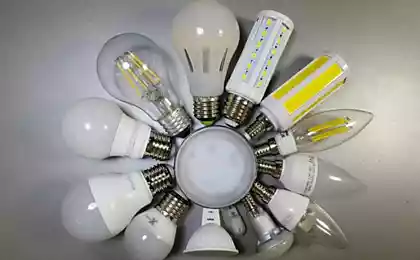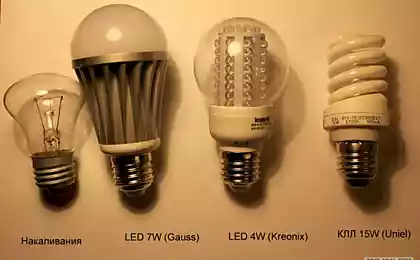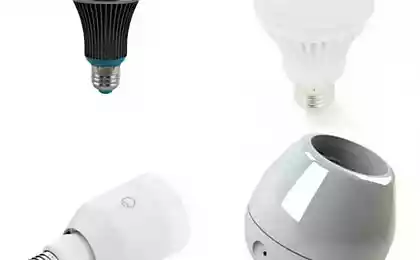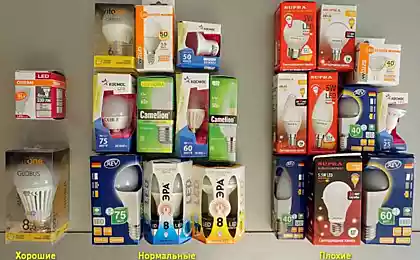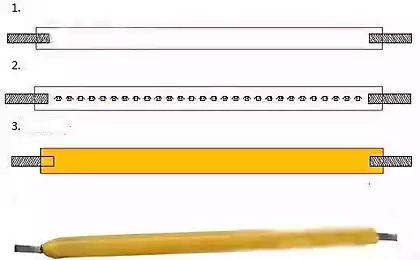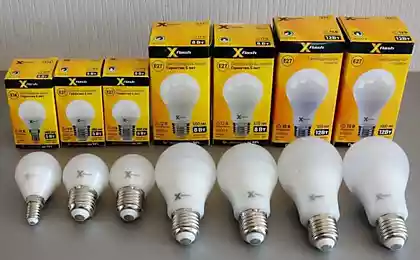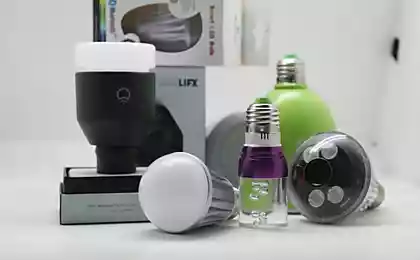617
Lamps FIPEL - a new energy-saving lighting technology
On lighting accounts for a large share of energy consumption in the world, such as it is believed that about 12 percent of the total energy consumption accounted for by lighting. The reason is that it is very common today, the traditional incandescent bulbs (light bulbs Illich we, or Edison light bulb - in the US) consume a lot of energy, 90 percent of the energy is simply lost to them in the form of heat
. The main alternative to this day there were only compact fluorescent lamps and LEDs, which consume considerably less energy can produce as much light as an incandescent lamp. However, on the fourth option approach lighting, and technology called FIPEL, already widely regarded as the first in 30 years, claiming the title of the new energy-saving lighting technology. FIPEL of Field-induced polymer electroluminescent (polymer electroluminescence induced field). Developed a new light source a professor of physics at the University of Wake is Forest (North Carolina), Dr. David Carroll.
For an explanation of how this technology works, Dr. Carroll offers to remember how to operate a microwave. Take for example the potato. If you put it in the microwave, and include warm-up, the device will act on potato microwaves, generating bias currents, forcing the water molecules inside the potatoes to move back and forth, with the heat from the inside of the product will occur.
Dr. Carroll and his team have developed a special type of plastic, which is in contact with an electric current induced in this way the bias current. In the latter case the plastic is not heated, and light emission.
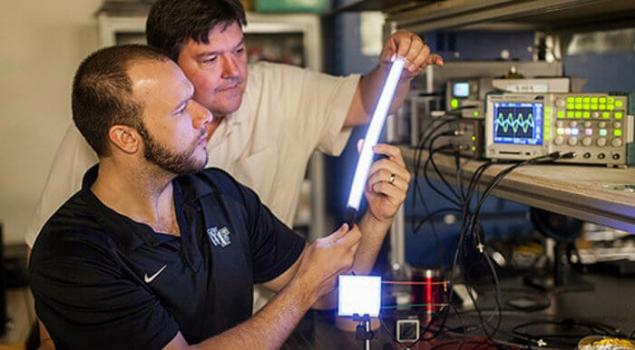
The new light source is made of several layers of very, very thin plastic, each layer in this case is 100,000 times thinner than a human hair. Plastic placed between two electrodes, one of which is aluminum and the other - and also a transparent conductive. When current passes through the device, the plastic is stimulated and glows.
Basis Technology - monostennymi doped nanotubes and iridium compounds, polyvinylcarbazole resin. Reached by researchers brightness exceeds 18,000 cd / m², which already allows to cover large areas without having to become very hot transitions LED technology in FIPEL no such intense heat, as with other lighting solutions.
Fortunately for David Carroll, FIPEL appeared in time, because now just a time when new technologies in lighting in demand as never before, as the production of traditional incandescent lamps is turned off rapidly.
Manufacturers claim that FIPEL technology has no analogues. For example, compact fluorescent lamps are used for lighting by 75 percent less electricity than incandescent bulbs, but LEDs and even less. This means that the CFL gives as much light as a 100-watt incandescent bulb, while consuming 23 watts, and the light-emitting diode (LED) - 20 watts. FIPEL, in turn, more efficient compact fluorescent lamps and LED are equal in effectiveness, but have a number of advantages.
CFLs contain mercury, which is toxic, and need proper disposal. Future bulbs FIPEL technology will not be any other toxic or corrosive chemicals, as this - just plastic, and they can be disposed of as plastic
. LEDs often have a bluish tint that many do not like, and color rendition in LEDs is not always the best. FIPEL can be of any color, including yellow sun shade, to which our eyes are accustomed to the process of evolution, which is the most comfortable for us.

Although the new light source and does not have the shape of a traditional light bulb, it is more similar in shape to a large panel nevertheless form can be changed, and then the lamp is easy to fit into any interior, being installed in a standard cartridge. Lifetime FIPEL also comparable with LEDs - from 25,000 to 50,000 hours
. However, it was not without flaws. Dr. Carroll noted that FIPEL efficiency technology is still a little less than can be achieved with the use of LEDs and LED light sources is almost the best at the moment. Despite this, Dr. Carroll hopes to see their offspring on the market by 2017.
. The main alternative to this day there were only compact fluorescent lamps and LEDs, which consume considerably less energy can produce as much light as an incandescent lamp. However, on the fourth option approach lighting, and technology called FIPEL, already widely regarded as the first in 30 years, claiming the title of the new energy-saving lighting technology. FIPEL of Field-induced polymer electroluminescent (polymer electroluminescence induced field). Developed a new light source a professor of physics at the University of Wake is Forest (North Carolina), Dr. David Carroll.
For an explanation of how this technology works, Dr. Carroll offers to remember how to operate a microwave. Take for example the potato. If you put it in the microwave, and include warm-up, the device will act on potato microwaves, generating bias currents, forcing the water molecules inside the potatoes to move back and forth, with the heat from the inside of the product will occur.
Dr. Carroll and his team have developed a special type of plastic, which is in contact with an electric current induced in this way the bias current. In the latter case the plastic is not heated, and light emission.

The new light source is made of several layers of very, very thin plastic, each layer in this case is 100,000 times thinner than a human hair. Plastic placed between two electrodes, one of which is aluminum and the other - and also a transparent conductive. When current passes through the device, the plastic is stimulated and glows.
Basis Technology - monostennymi doped nanotubes and iridium compounds, polyvinylcarbazole resin. Reached by researchers brightness exceeds 18,000 cd / m², which already allows to cover large areas without having to become very hot transitions LED technology in FIPEL no such intense heat, as with other lighting solutions.
Fortunately for David Carroll, FIPEL appeared in time, because now just a time when new technologies in lighting in demand as never before, as the production of traditional incandescent lamps is turned off rapidly.
Manufacturers claim that FIPEL technology has no analogues. For example, compact fluorescent lamps are used for lighting by 75 percent less electricity than incandescent bulbs, but LEDs and even less. This means that the CFL gives as much light as a 100-watt incandescent bulb, while consuming 23 watts, and the light-emitting diode (LED) - 20 watts. FIPEL, in turn, more efficient compact fluorescent lamps and LED are equal in effectiveness, but have a number of advantages.
CFLs contain mercury, which is toxic, and need proper disposal. Future bulbs FIPEL technology will not be any other toxic or corrosive chemicals, as this - just plastic, and they can be disposed of as plastic
. LEDs often have a bluish tint that many do not like, and color rendition in LEDs is not always the best. FIPEL can be of any color, including yellow sun shade, to which our eyes are accustomed to the process of evolution, which is the most comfortable for us.

Although the new light source and does not have the shape of a traditional light bulb, it is more similar in shape to a large panel nevertheless form can be changed, and then the lamp is easy to fit into any interior, being installed in a standard cartridge. Lifetime FIPEL also comparable with LEDs - from 25,000 to 50,000 hours
. However, it was not without flaws. Dr. Carroll noted that FIPEL efficiency technology is still a little less than can be achieved with the use of LEDs and LED light sources is almost the best at the moment. Despite this, Dr. Carroll hopes to see their offspring on the market by 2017.
The new project from Toyota: the wind turn into hydrogen and hydrogen fuel -to
Secrets of orchid breeding: how one plant to turn 100!
